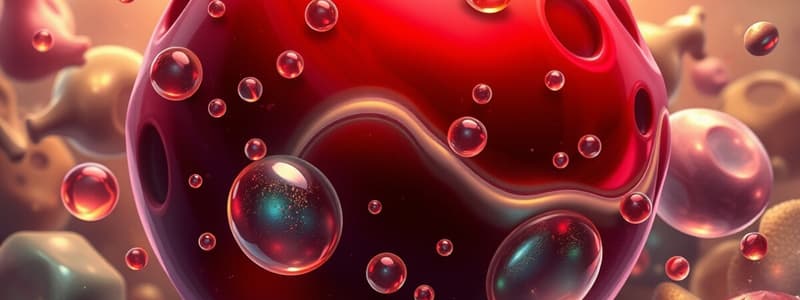Podcast
Questions and Answers
Which major classes of lipoproteins are primarily responsible for transporting dietary lipids from the intestine?
Which major classes of lipoproteins are primarily responsible for transporting dietary lipids from the intestine?
- VLDL and Chylomicrons (correct)
- LDL and IDL
- VLDL and HDL
- IDL and HDL
What is the primary component of VLDL (Very Low-Density Lipoprotein) production occurs from?
What is the primary component of VLDL (Very Low-Density Lipoprotein) production occurs from?
- Dietary protein
- Dietary carbohydrate (correct)
- Dietary fat
- Lipid from muscle cells
Which type of lipid is characterized by containing sphingosine and carbohydrate?
Which type of lipid is characterized by containing sphingosine and carbohydrate?
- Phospholipids
- Glycolipids (correct)
- Triglycerides
- Steroid hormones
What is the role of fat-soluble vitamins in the body?
What is the role of fat-soluble vitamins in the body?
During lipid digestion, where does the primary catalyzation by lingual lipase begin?
During lipid digestion, where does the primary catalyzation by lingual lipase begin?
Which lipid subtype is derived from cholesterol and includes substances like bile salts?
Which lipid subtype is derived from cholesterol and includes substances like bile salts?
What is a common structural feature of fatty acids, particularly when considering their carbon chain?
What is a common structural feature of fatty acids, particularly when considering their carbon chain?
Which of the following statements best describes the digestion of lipids in the mouth?
Which of the following statements best describes the digestion of lipids in the mouth?
What characteristic differentiates waxes from other types of lipids?
What characteristic differentiates waxes from other types of lipids?
What type of phospholipid contains glycerol as its backbone?
What type of phospholipid contains glycerol as its backbone?
What is the primary type of lipid contained in dietary intake?
What is the primary type of lipid contained in dietary intake?
Which lipoprotein is primarily responsible for the transport of triglycerides from the liver to peripheral tissues?
Which lipoprotein is primarily responsible for the transport of triglycerides from the liver to peripheral tissues?
Which of the following statements about complex lipids is incorrect?
Which of the following statements about complex lipids is incorrect?
What solvent is primarily used to extract lipids from tissues?
What solvent is primarily used to extract lipids from tissues?
Which of these is considered a simple lipid?
Which of these is considered a simple lipid?
What is the role of glycerol in triacylglycerols?
What is the role of glycerol in triacylglycerols?
Which lipids are most likely to be synthesized in the liver?
Which lipids are most likely to be synthesized in the liver?
What is a characteristic feature of lipids regarding their solubility?
What is a characteristic feature of lipids regarding their solubility?
Which of the following is not classified as a complex lipid?
Which of the following is not classified as a complex lipid?
Flashcards are hidden until you start studying
Study Notes
Overview of Dietary Lipids
- Waxes are formed from fatty acid esters and higher molecular weight monohydric alcohols.
- Lipids are extracted from tissues using non-polar solvents and are insoluble in water, facilitating compartmentalization.
- Daily lipid intake ranges from 60 to 150 grams, predominantly comprised of triglycerides (90%), alongside cholesterol, cholesteryl esters, phospholipids, and free fatty acids.
Types of Lipids
- Complex Lipids:
- Consist of fatty acid esters, incorporating additional groups beyond an alcohol and fatty acid.
- Includes phospholipids, glycolipids (e.g., glycosphingolipids), and various other types like sulfolipids and aminolipids.
- Phospholipids typically contain a fatty acid, alcohol, a phosphoric acid residue, and may include nitrogenous bases.
- Glycerophospholipids have glycerol as the alcohol component.
- Sphingophospholipids utilize sphingosine as the alcohol.
- Glycolipids are derived from fatty acids, sphingosine, and carbohydrates.
Transport and Function of Lipids
- Triglycerides (TAGs) are sourced from diet or synthesized in the liver and transported via lipoproteins in the bloodstream.
- Major classes of lipoproteins involved in transport:
- Chylomicrons: formed in the intestines from dietary lipids.
- Very Low-Density Lipoprotein (VLDL): produced in the liver, primarily from dietary carbohydrates.
- Intermediate-Density Lipoprotein (IDL) and Low-Density Lipoprotein (LDL): generated from TAG digestion of VLDL in blood capillaries.
- Lipids serve as a major energy source and include cholesterol, bile salts, steroid hormones (derived from cholesterol), and fat-soluble vitamins (A, D, E, K) with regulatory functions.
Fatty Acids and Their Characteristics
- Typically possess an even number of carbon atoms, ranging from 16 to 20.
- Can be saturated (no double bonds) or unsaturated (possessing double bonds).
Digestive Process of Dietary Lipids
- Lipid digestion starts in the stomach, aided by lingual lipase, an acid-stable enzyme produced by glands at the rear of the tongue.
- In the mouth, lipids remain unchanged, but in the stomach, digestion initiates with the action of the lingual lipase on TAGs, particularly those with short or medium chain fatty acids.
Studying That Suits You
Use AI to generate personalized quizzes and flashcards to suit your learning preferences.



